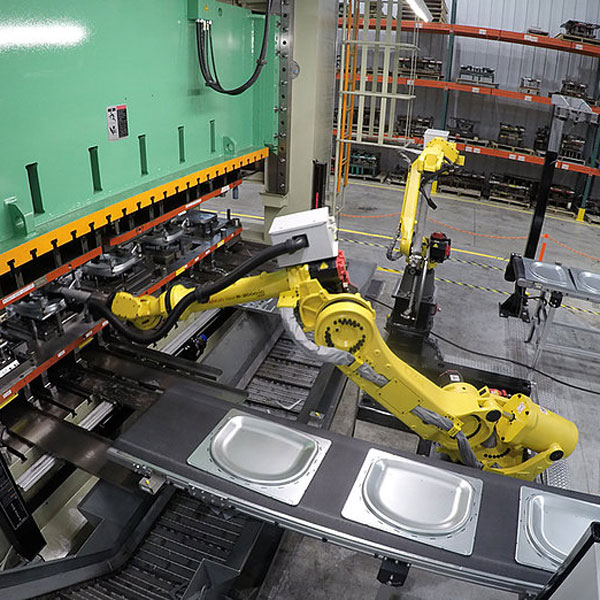Metal Stamping: Innovations Driving Industry Growth
Metal Stamping: Innovations Driving Industry Growth
Blog Article
Opening the Power of Metal Stamping: Strategies for Boosted Product Growth
In the realm of manufacturing, the use of metal stamping holds a considerable location due to its convenience and performance in generating intricate components and parts. Nonetheless, real capacity of steel marking stays untapped by several companies seeking to enhance their product advancement procedures. By checking out innovative techniques and techniques customized to maximize design, product selection, production efficiency, and top quality control, organizations can unlock a riches of possibilities to raise their products to brand-new heights of development and efficiency.
Benefits of Steel Stamping
Steel stamping offers a effective and economical technique for creating high-grade metal parts. This production procedure entails shaping, reducing, or developing steel sheets utilizing a stamping press (Metal Stamping). One of the crucial advantages of metal stamping is its ability to create complicated geometries with high accuracy and consistency. This is especially useful for industries such as vehicle, aerospace, and electronics, where intricate steel components are commonly called for.
In addition, metal stamping enables for high-volume production, making it perfect for projects that need large amounts of steel parts. The rate and repeatability of the marking process not just make sure cost savings but also add to faster turn-around times for manufacturing orders. Additionally, making use of automated equipment in metal marking aids reduce the threat of human mistake, causing boosted overall item quality.

Design Optimization Techniques
Via mindful consideration of product residential properties and geometric configurations, design optimization methods play a critical role in improving the efficiency and capability of metal stamping processes. By strategically examining elements such as material density, kind, and strength, manufacturers can customize the design to take full advantage of the efficiency of the marking procedure. Using simulation software application, engineers can forecast just how various design variations will act under different stamping problems, permitting the recognition of prospective issues before manufacturing begins.
Additionally, incorporating features like fillets, chamfers, and embosses right into the design can enhance the overall top quality of the stamped component while decreasing the threat of flaws such as deforming or fracturing. Furthermore, maximizing the design of features on the component can enhance the product circulation throughout stamping, leading to more regular and specific end results.
Essentially, style optimization strategies allow makers to adjust their steel stamping processes, causing improved product top quality, enhanced manufacturing efficiency, and eventually, a more competitive setting on the market.
Material Choice Techniques
Style optimization techniques in metal marking procedures greatly count on critical product choice techniques to ensure the desired efficiency and performance of the manufactured components. The option of product in steel stamping is crucial as it straight impacts the high quality, resilience, and overall functionality of the last item. When selecting the proper material for a particular job, factors such as mechanical buildings, formability, deterioration, and cost-effectiveness resistance need to be considered.

Stabilizing the efficiency requirements with the overall cost of products is necessary to make sure the economic viability of the production process. By thoroughly assessing these facets, suppliers can maximize their material selection techniques to accomplish remarkable item quality and functional efficiency.
Enhancing Manufacturing Performance
Effectiveness in manufacturing processes is an essential variable for making sure cost-effectiveness and timely delivery of premium steel marked parts. To improve manufacturing performance in steel marking, a number of techniques can be carried out. One crucial method is enhancing the tooling design to lessen material waste and minimize manufacturing time. By using advanced simulation software application, producers can fine-tune the tooling and examine design prior to real production, consequently streamlining the stamping process and boosting total performance.
In addition, implementing automation and robotics in metal stamping procedures can considerably raise productivity and uniformity while reducing labor costs. Automated systems can execute repeated jobs with high accuracy and speed, causing boosted production efficiency and greater result rates. Investing in contemporary marking equipment with sophisticated functions, such as servo-driven presses and quick die adjustment systems, can additionally maximize production processes and lessen downtime.
In addition, developing clear interaction channels and cultivating cooperation in between design, design, and manufacturing groups is important for identifying potential bottlenecks and implementing continuous improvements in the production workflow - Metal Stamping. By embracing lean manufacturing concepts and leveraging modern technology advancements, producers can unlock the complete potential of steel stamping processes and achieve higher manufacturing effectiveness
Quality Assurance and Evaluation Approaches
To make sure the constant production of premium steel marked parts, extensive quality assurance and assessment techniques play a crucial duty in validating the precision and honesty of the production process. Quality control in metal marking entails a collection of systematic checks and procedures to ensure that each part fulfills the specified demands. Assessment approaches such as aesthetic exam, dimensional evaluation, and material screening are typically utilized to assess the quality of stamped elements. Aesthetic inspections ensure the surface finish and integrity of the components, while dimensional evaluation confirms that the components adapt to the needed requirements. Product testing methods like solidity testing and product make-up evaluation important source help validate the material buildings and architectural integrity of the stamped components. Additionally, advanced technologies such as automated optical assessment systems and coordinate gauging makers are progressively being used to improve the precision and performance of quality control processes in steel marking. By implementing durable quality assurance and examination approaches, suppliers can maintain high requirements of high quality and uniformity in their steel stamped items.
Conclusion
In final thought, metal stamping deals various advantages such as cost-effectiveness, accuracy, and convenience in item development. On the whole, unlocking the power of metal stamping calls for a tactical approach to enhance product advancement processes.
Metal marking offers a cost-efficient and efficient approach for generating top notch metal parts.Furthermore, steel marking enables for high-volume manufacturing, making it ideal for projects that call for large amounts of steel parts.With mindful consideration of product homes and geometric arrangements, design optimization strategies play a vital duty in enhancing the performance and capability of metal marking Learn More Here procedures.Layout optimization strategies in steel stamping processes greatly count on calculated material selection approaches to guarantee the desired performance and performance of the manufactured components. The option of product in metal marking is important as it directly affects the top quality, sturdiness, and overall capability of the final product.
Report this page